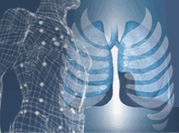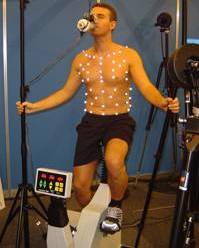


The mouthpiece and the noseclip also make the subject aware that his breathing is being measured and therefore interfere with the natural pattern of breathing and its neural control. Besides, they cannot be used on children or uncooperative adults, or during sleep, phonation and weaning from mechanical ventilation because may require excessive patient cooperation. Integration of flow at the mouth suffers from integrator drift, even with the most sophisticated digital integrators, so that changes in absolute lung volume can not be reliably recorded. These problems have induced investigators to attempt to measure ventilation indirectly by recording the motion of the chest wall, which reflects the changes of thoracic gas volume and therefore can be used to estimate them. Opto-electronic plethysmography is an innovative technique to investigate the respiratory system resulting from the research performed by the Politecnico di Milano in collaboration with medical and scientific Institutions, international leaders in this fields. OEP System measures the changes of the complex shape of the chest wall during breathing by modeling the thoraco-abdominal surface with a large number of points belonging to selected anatomical reference sites of the rib cage and abdomen. The automatic motion analyzer on which it is based uses passive markers composed of a thin film of retro-reflective paper on plastic hemispheres (5-10 mm diameter). The markers are placed on the skin by bi-adhesive hypoallergenic tape. Special video cameras (solid state CCDs) operate up to 120 frames per second synchronized with coaxial infrared flashing LEDís. A dedicated software computes with high accuracy the 3D coordinates of the different markers. No specific calibration is required besides the initial one, performed during the installation of the system. OEP System uses the accurate measurement of the three-dimensional micro-movement of the points belonging to the chest wall to compute chest wall volumes. Special algorithms allow to obtain volume variations of the whole chest wall and of the different compartments. Time courses of these signals can be obtained at different sampling frequencies, up to 120 Hz. Several studies have been conducted under different conditions and have shown that the method provides a very accurate measurement of the volume of the chest wall and its variations during respiration. Opto-electronic Plethysmography has the great advantage that it can measure breathing patterns in any condition, both in health and disease, and it can be used to study respiratory kinematics and, if combined with pressure measurements, statics, dynamics and energetics. |
 Pulmonary ventilation is usually measured by a spirometer or a pneumotachograph,
which require a mouthpiece, with the nose occluded by a noseclip.
Even if this approach is widely used, it is impractical for prolonged
measurement, it limits subjectís mobility and introduces additional
dead space and thereby increases the tidal volume.
Pulmonary ventilation is usually measured by a spirometer or a pneumotachograph,
which require a mouthpiece, with the nose occluded by a noseclip.
Even if this approach is widely used, it is impractical for prolonged
measurement, it limits subjectís mobility and introduces additional
dead space and thereby increases the tidal volume.